Organizational Behavior: Leadership and Conflict Analysis
VerifiedAdded on 2022/08/26
|9
|2259
|17
Essay
AI Summary
This essay delves into leadership and conflict management within criminal justice organizations. It begins by examining Fiedler's original Model of Leadership and comparing it to his Cognitive Resource Theory, exploring the suitability of intelligent versus experienced leaders in high and low-stress scenarios. The essay then defines and provides real-world examples of Transactional, Transformational, and Visionary Leadership styles within a criminal justice context. It analyzes organizational conflict, contrasting traditional, human relations, and interactionist views, and explores the application of Thomas Kilmann's conflict modes. The essay concludes by summarizing key leadership theories and their practical implications for effective management and conflict resolution in the criminal justice system. The paper uses cited references to support the claims and arguments made in the essay.

MANAGEMENT
STUDENT DETAILS
STUDENT DETAILS
STUDENT DETAILS
STUDENT DETAILS
Paraphrase This Document
Need a fresh take? Get an instant paraphrase of this document with our AI Paraphraser
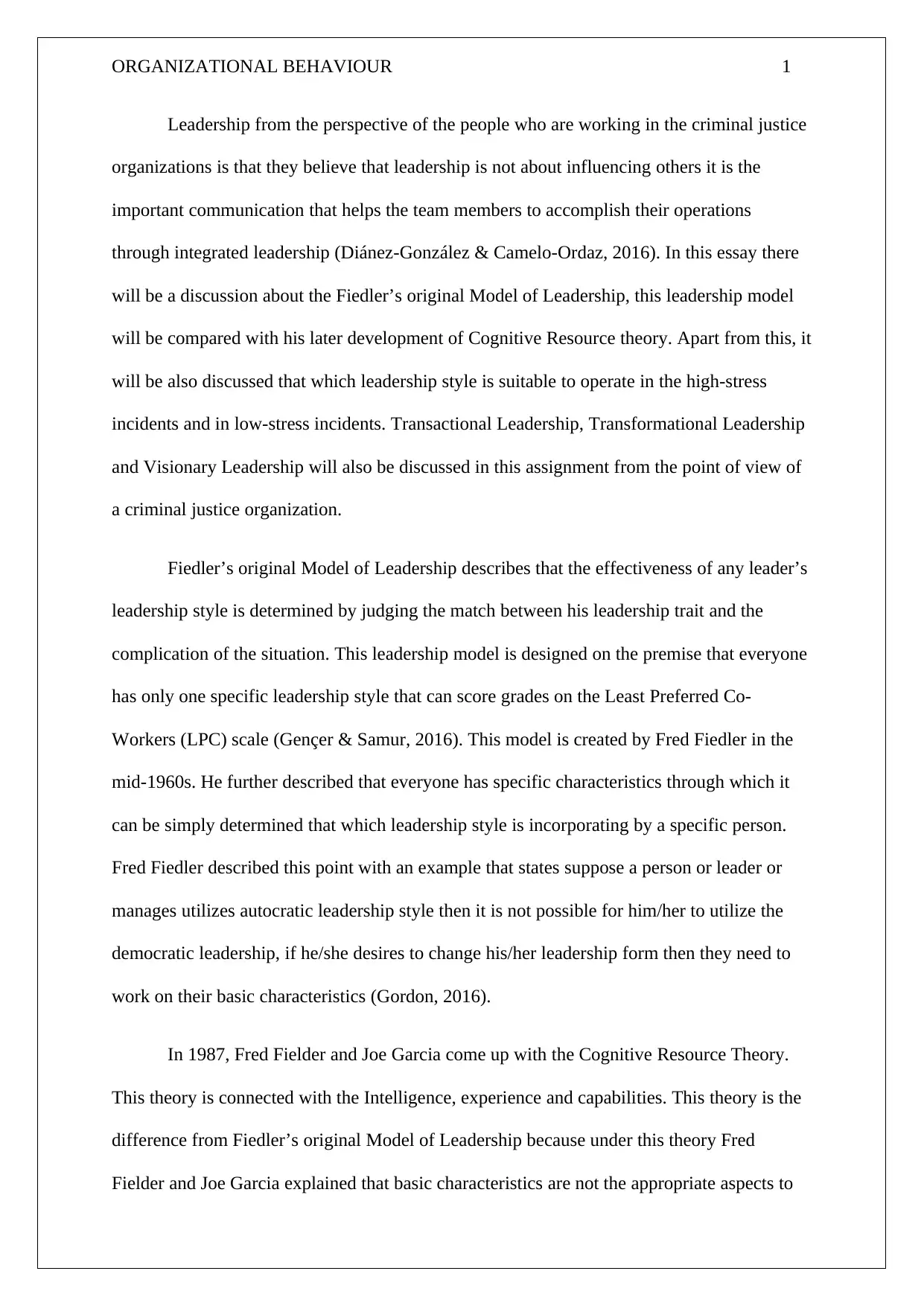
ORGANIZATIONAL BEHAVIOUR 1
Leadership from the perspective of the people who are working in the criminal justice
organizations is that they believe that leadership is not about influencing others it is the
important communication that helps the team members to accomplish their operations
through integrated leadership (Diánez-González & Camelo-Ordaz, 2016). In this essay there
will be a discussion about the Fiedler’s original Model of Leadership, this leadership model
will be compared with his later development of Cognitive Resource theory. Apart from this, it
will be also discussed that which leadership style is suitable to operate in the high-stress
incidents and in low-stress incidents. Transactional Leadership, Transformational Leadership
and Visionary Leadership will also be discussed in this assignment from the point of view of
a criminal justice organization.
Fiedler’s original Model of Leadership describes that the effectiveness of any leader’s
leadership style is determined by judging the match between his leadership trait and the
complication of the situation. This leadership model is designed on the premise that everyone
has only one specific leadership style that can score grades on the Least Preferred Co-
Workers (LPC) scale (Gençer & Samur, 2016). This model is created by Fred Fiedler in the
mid-1960s. He further described that everyone has specific characteristics through which it
can be simply determined that which leadership style is incorporating by a specific person.
Fred Fiedler described this point with an example that states suppose a person or leader or
manages utilizes autocratic leadership style then it is not possible for him/her to utilize the
democratic leadership, if he/she desires to change his/her leadership form then they need to
work on their basic characteristics (Gordon, 2016).
In 1987, Fred Fielder and Joe Garcia come up with the Cognitive Resource Theory.
This theory is connected with the Intelligence, experience and capabilities. This theory is the
difference from Fiedler’s original Model of Leadership because under this theory Fred
Fielder and Joe Garcia explained that basic characteristics are not the appropriate aspects to
Leadership from the perspective of the people who are working in the criminal justice
organizations is that they believe that leadership is not about influencing others it is the
important communication that helps the team members to accomplish their operations
through integrated leadership (Diánez-González & Camelo-Ordaz, 2016). In this essay there
will be a discussion about the Fiedler’s original Model of Leadership, this leadership model
will be compared with his later development of Cognitive Resource theory. Apart from this, it
will be also discussed that which leadership style is suitable to operate in the high-stress
incidents and in low-stress incidents. Transactional Leadership, Transformational Leadership
and Visionary Leadership will also be discussed in this assignment from the point of view of
a criminal justice organization.
Fiedler’s original Model of Leadership describes that the effectiveness of any leader’s
leadership style is determined by judging the match between his leadership trait and the
complication of the situation. This leadership model is designed on the premise that everyone
has only one specific leadership style that can score grades on the Least Preferred Co-
Workers (LPC) scale (Gençer & Samur, 2016). This model is created by Fred Fiedler in the
mid-1960s. He further described that everyone has specific characteristics through which it
can be simply determined that which leadership style is incorporating by a specific person.
Fred Fiedler described this point with an example that states suppose a person or leader or
manages utilizes autocratic leadership style then it is not possible for him/her to utilize the
democratic leadership, if he/she desires to change his/her leadership form then they need to
work on their basic characteristics (Gordon, 2016).
In 1987, Fred Fielder and Joe Garcia come up with the Cognitive Resource Theory.
This theory is connected with the Intelligence, experience and capabilities. This theory is the
difference from Fiedler’s original Model of Leadership because under this theory Fred
Fielder and Joe Garcia explained that basic characteristics are not the appropriate aspects to
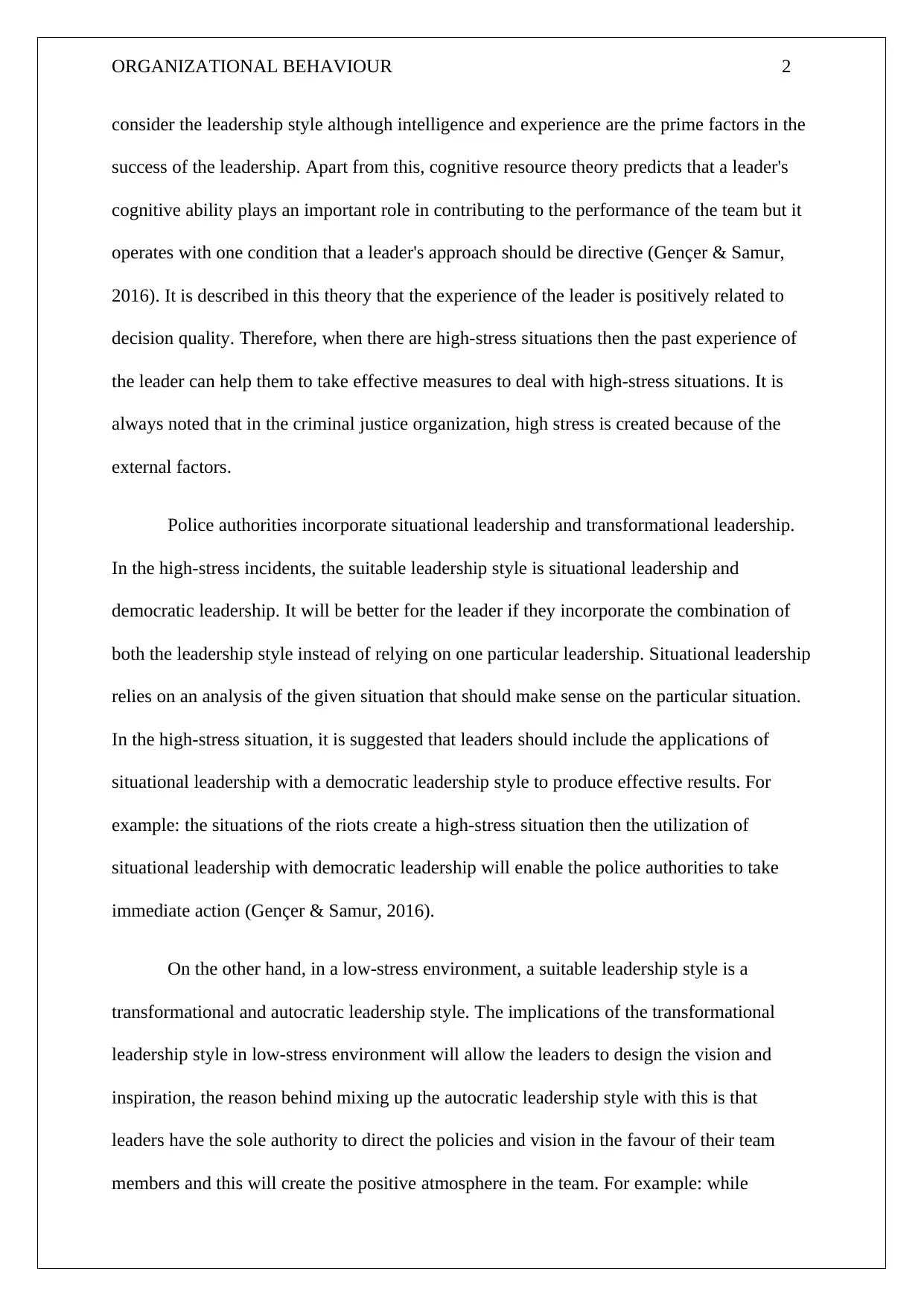
ORGANIZATIONAL BEHAVIOUR 2
consider the leadership style although intelligence and experience are the prime factors in the
success of the leadership. Apart from this, cognitive resource theory predicts that a leader's
cognitive ability plays an important role in contributing to the performance of the team but it
operates with one condition that a leader's approach should be directive (Gençer & Samur,
2016). It is described in this theory that the experience of the leader is positively related to
decision quality. Therefore, when there are high-stress situations then the past experience of
the leader can help them to take effective measures to deal with high-stress situations. It is
always noted that in the criminal justice organization, high stress is created because of the
external factors.
Police authorities incorporate situational leadership and transformational leadership.
In the high-stress incidents, the suitable leadership style is situational leadership and
democratic leadership. It will be better for the leader if they incorporate the combination of
both the leadership style instead of relying on one particular leadership. Situational leadership
relies on an analysis of the given situation that should make sense on the particular situation.
In the high-stress situation, it is suggested that leaders should include the applications of
situational leadership with a democratic leadership style to produce effective results. For
example: the situations of the riots create a high-stress situation then the utilization of
situational leadership with democratic leadership will enable the police authorities to take
immediate action (Gençer & Samur, 2016).
On the other hand, in a low-stress environment, a suitable leadership style is a
transformational and autocratic leadership style. The implications of the transformational
leadership style in low-stress environment will allow the leaders to design the vision and
inspiration, the reason behind mixing up the autocratic leadership style with this is that
leaders have the sole authority to direct the policies and vision in the favour of their team
members and this will create the positive atmosphere in the team. For example: while
consider the leadership style although intelligence and experience are the prime factors in the
success of the leadership. Apart from this, cognitive resource theory predicts that a leader's
cognitive ability plays an important role in contributing to the performance of the team but it
operates with one condition that a leader's approach should be directive (Gençer & Samur,
2016). It is described in this theory that the experience of the leader is positively related to
decision quality. Therefore, when there are high-stress situations then the past experience of
the leader can help them to take effective measures to deal with high-stress situations. It is
always noted that in the criminal justice organization, high stress is created because of the
external factors.
Police authorities incorporate situational leadership and transformational leadership.
In the high-stress incidents, the suitable leadership style is situational leadership and
democratic leadership. It will be better for the leader if they incorporate the combination of
both the leadership style instead of relying on one particular leadership. Situational leadership
relies on an analysis of the given situation that should make sense on the particular situation.
In the high-stress situation, it is suggested that leaders should include the applications of
situational leadership with a democratic leadership style to produce effective results. For
example: the situations of the riots create a high-stress situation then the utilization of
situational leadership with democratic leadership will enable the police authorities to take
immediate action (Gençer & Samur, 2016).
On the other hand, in a low-stress environment, a suitable leadership style is a
transformational and autocratic leadership style. The implications of the transformational
leadership style in low-stress environment will allow the leaders to design the vision and
inspiration, the reason behind mixing up the autocratic leadership style with this is that
leaders have the sole authority to direct the policies and vision in the favour of their team
members and this will create the positive atmosphere in the team. For example: while
⊘ This is a preview!⊘
Do you want full access?
Subscribe today to unlock all pages.

Trusted by 1+ million students worldwide
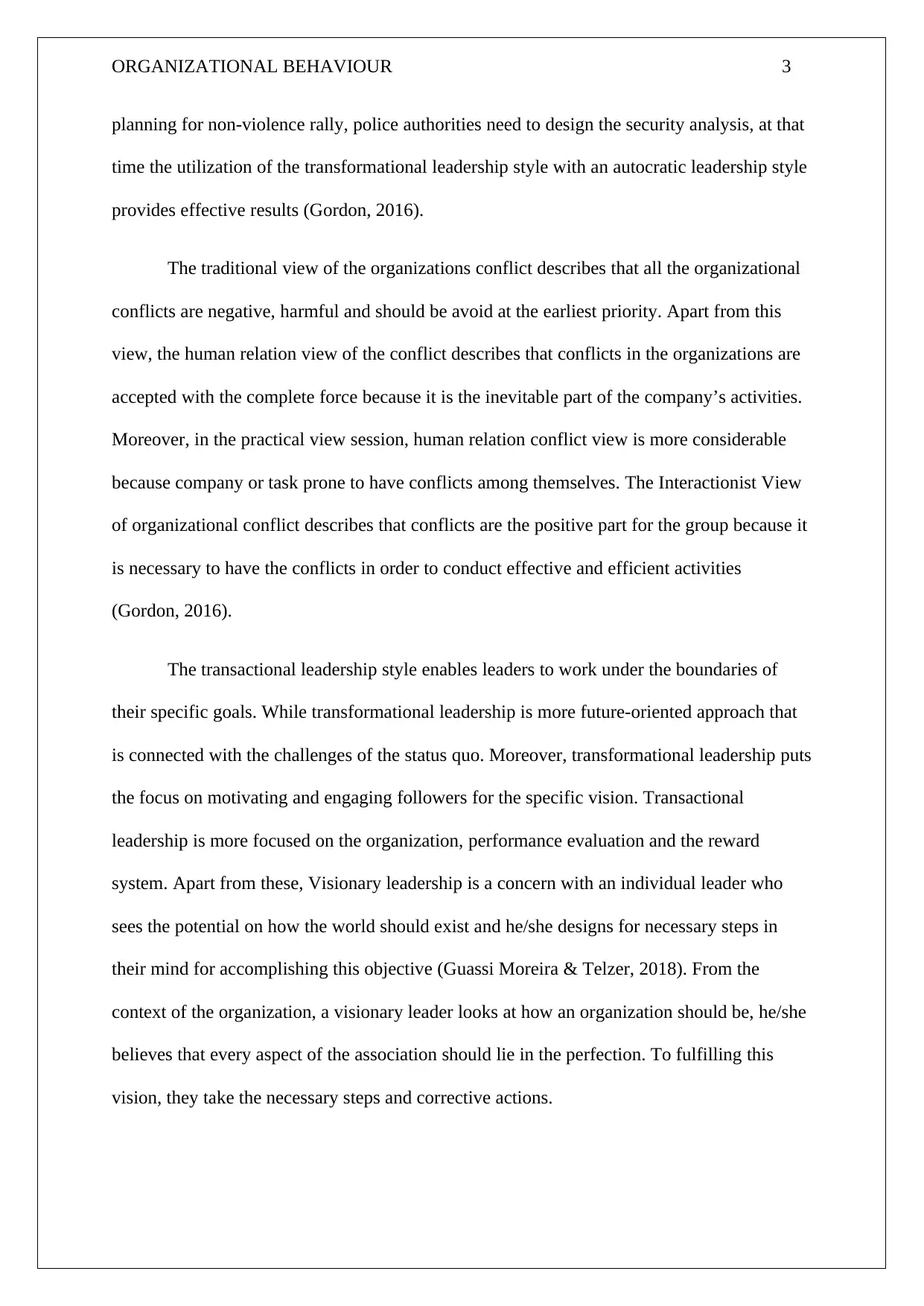
ORGANIZATIONAL BEHAVIOUR 3
planning for non-violence rally, police authorities need to design the security analysis, at that
time the utilization of the transformational leadership style with an autocratic leadership style
provides effective results (Gordon, 2016).
The traditional view of the organizations conflict describes that all the organizational
conflicts are negative, harmful and should be avoid at the earliest priority. Apart from this
view, the human relation view of the conflict describes that conflicts in the organizations are
accepted with the complete force because it is the inevitable part of the company’s activities.
Moreover, in the practical view session, human relation conflict view is more considerable
because company or task prone to have conflicts among themselves. The Interactionist View
of organizational conflict describes that conflicts are the positive part for the group because it
is necessary to have the conflicts in order to conduct effective and efficient activities
(Gordon, 2016).
The transactional leadership style enables leaders to work under the boundaries of
their specific goals. While transformational leadership is more future-oriented approach that
is connected with the challenges of the status quo. Moreover, transformational leadership puts
the focus on motivating and engaging followers for the specific vision. Transactional
leadership is more focused on the organization, performance evaluation and the reward
system. Apart from these, Visionary leadership is a concern with an individual leader who
sees the potential on how the world should exist and he/she designs for necessary steps in
their mind for accomplishing this objective (Guassi Moreira & Telzer, 2018). From the
context of the organization, a visionary leader looks at how an organization should be, he/she
believes that every aspect of the association should lie in the perfection. To fulfilling this
vision, they take the necessary steps and corrective actions.
planning for non-violence rally, police authorities need to design the security analysis, at that
time the utilization of the transformational leadership style with an autocratic leadership style
provides effective results (Gordon, 2016).
The traditional view of the organizations conflict describes that all the organizational
conflicts are negative, harmful and should be avoid at the earliest priority. Apart from this
view, the human relation view of the conflict describes that conflicts in the organizations are
accepted with the complete force because it is the inevitable part of the company’s activities.
Moreover, in the practical view session, human relation conflict view is more considerable
because company or task prone to have conflicts among themselves. The Interactionist View
of organizational conflict describes that conflicts are the positive part for the group because it
is necessary to have the conflicts in order to conduct effective and efficient activities
(Gordon, 2016).
The transactional leadership style enables leaders to work under the boundaries of
their specific goals. While transformational leadership is more future-oriented approach that
is connected with the challenges of the status quo. Moreover, transformational leadership puts
the focus on motivating and engaging followers for the specific vision. Transactional
leadership is more focused on the organization, performance evaluation and the reward
system. Apart from these, Visionary leadership is a concern with an individual leader who
sees the potential on how the world should exist and he/she designs for necessary steps in
their mind for accomplishing this objective (Guassi Moreira & Telzer, 2018). From the
context of the organization, a visionary leader looks at how an organization should be, he/she
believes that every aspect of the association should lie in the perfection. To fulfilling this
vision, they take the necessary steps and corrective actions.
Paraphrase This Document
Need a fresh take? Get an instant paraphrase of this document with our AI Paraphraser
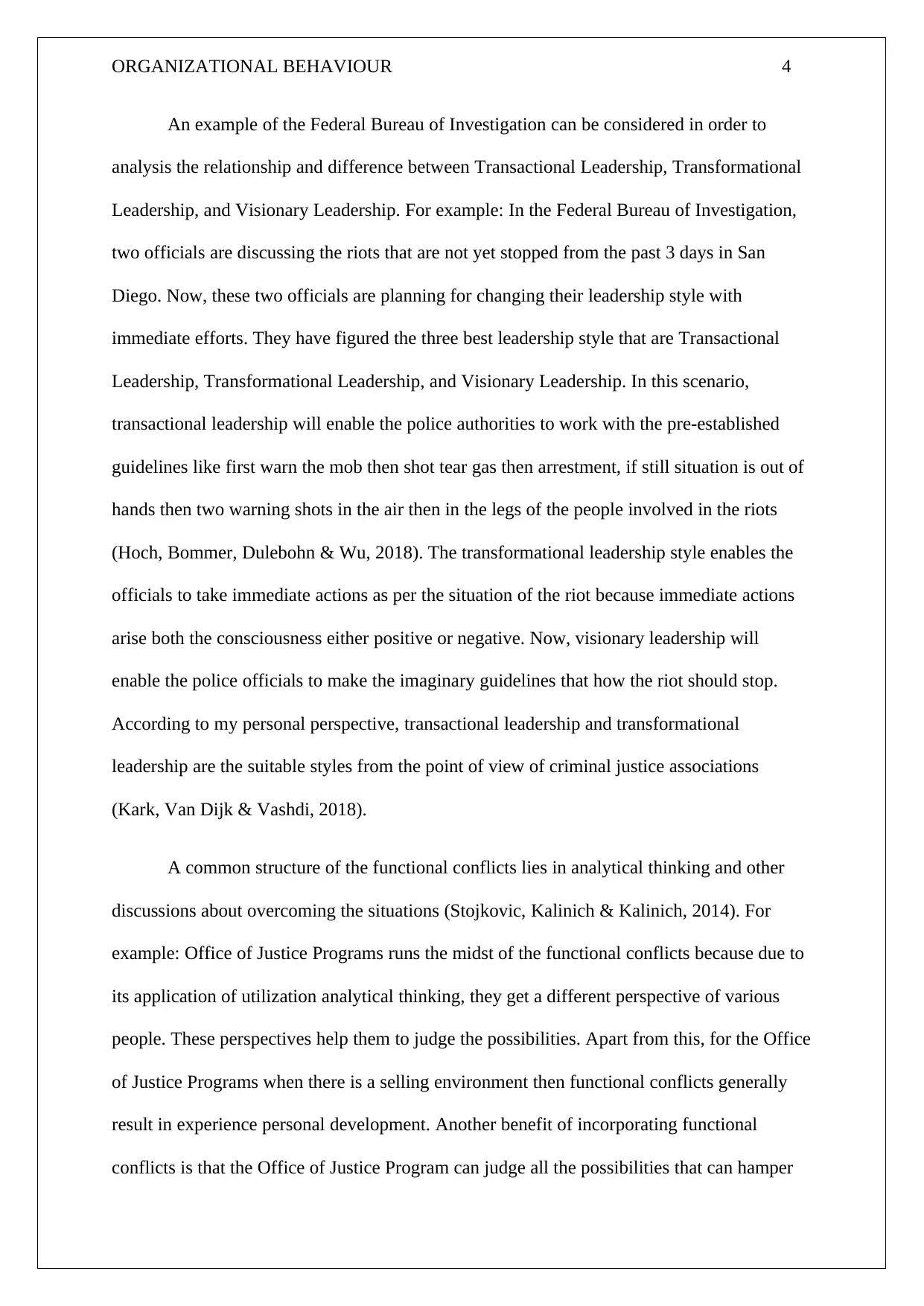
ORGANIZATIONAL BEHAVIOUR 4
An example of the Federal Bureau of Investigation can be considered in order to
analysis the relationship and difference between Transactional Leadership, Transformational
Leadership, and Visionary Leadership. For example: In the Federal Bureau of Investigation,
two officials are discussing the riots that are not yet stopped from the past 3 days in San
Diego. Now, these two officials are planning for changing their leadership style with
immediate efforts. They have figured the three best leadership style that are Transactional
Leadership, Transformational Leadership, and Visionary Leadership. In this scenario,
transactional leadership will enable the police authorities to work with the pre-established
guidelines like first warn the mob then shot tear gas then arrestment, if still situation is out of
hands then two warning shots in the air then in the legs of the people involved in the riots
(Hoch, Bommer, Dulebohn & Wu, 2018). The transformational leadership style enables the
officials to take immediate actions as per the situation of the riot because immediate actions
arise both the consciousness either positive or negative. Now, visionary leadership will
enable the police officials to make the imaginary guidelines that how the riot should stop.
According to my personal perspective, transactional leadership and transformational
leadership are the suitable styles from the point of view of criminal justice associations
(Kark, Van Dijk & Vashdi, 2018).
A common structure of the functional conflicts lies in analytical thinking and other
discussions about overcoming the situations (Stojkovic, Kalinich & Kalinich, 2014). For
example: Office of Justice Programs runs the midst of the functional conflicts because due to
its application of utilization analytical thinking, they get a different perspective of various
people. These perspectives help them to judge the possibilities. Apart from this, for the Office
of Justice Programs when there is a selling environment then functional conflicts generally
result in experience personal development. Another benefit of incorporating functional
conflicts is that the Office of Justice Program can judge all the possibilities that can hamper
An example of the Federal Bureau of Investigation can be considered in order to
analysis the relationship and difference between Transactional Leadership, Transformational
Leadership, and Visionary Leadership. For example: In the Federal Bureau of Investigation,
two officials are discussing the riots that are not yet stopped from the past 3 days in San
Diego. Now, these two officials are planning for changing their leadership style with
immediate efforts. They have figured the three best leadership style that are Transactional
Leadership, Transformational Leadership, and Visionary Leadership. In this scenario,
transactional leadership will enable the police authorities to work with the pre-established
guidelines like first warn the mob then shot tear gas then arrestment, if still situation is out of
hands then two warning shots in the air then in the legs of the people involved in the riots
(Hoch, Bommer, Dulebohn & Wu, 2018). The transformational leadership style enables the
officials to take immediate actions as per the situation of the riot because immediate actions
arise both the consciousness either positive or negative. Now, visionary leadership will
enable the police officials to make the imaginary guidelines that how the riot should stop.
According to my personal perspective, transactional leadership and transformational
leadership are the suitable styles from the point of view of criminal justice associations
(Kark, Van Dijk & Vashdi, 2018).
A common structure of the functional conflicts lies in analytical thinking and other
discussions about overcoming the situations (Stojkovic, Kalinich & Kalinich, 2014). For
example: Office of Justice Programs runs the midst of the functional conflicts because due to
its application of utilization analytical thinking, they get a different perspective of various
people. These perspectives help them to judge the possibilities. Apart from this, for the Office
of Justice Programs when there is a selling environment then functional conflicts generally
result in experience personal development. Another benefit of incorporating functional
conflicts is that the Office of Justice Program can judge all the possibilities that can hamper
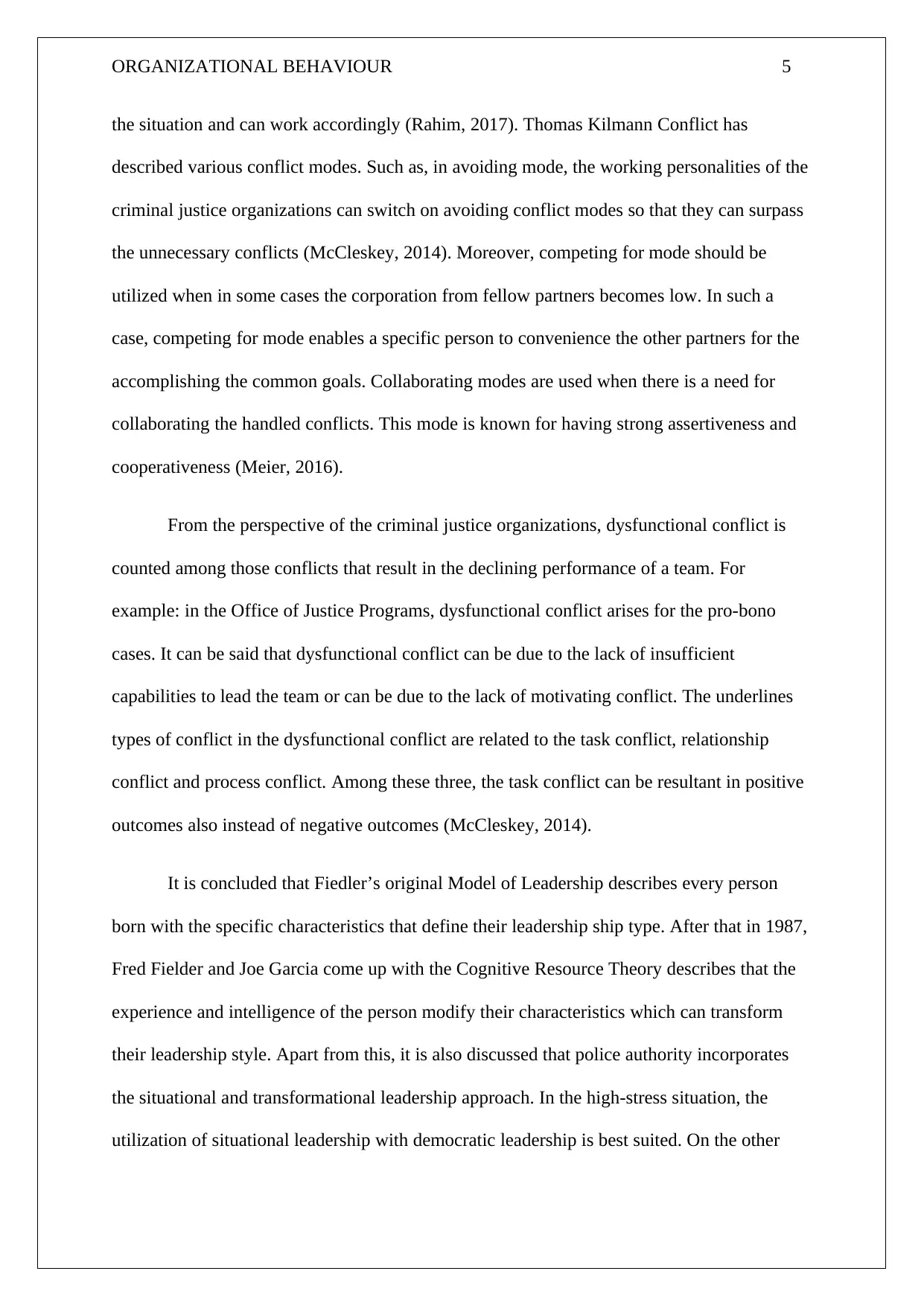
ORGANIZATIONAL BEHAVIOUR 5
the situation and can work accordingly (Rahim, 2017). Thomas Kilmann Conflict has
described various conflict modes. Such as, in avoiding mode, the working personalities of the
criminal justice organizations can switch on avoiding conflict modes so that they can surpass
the unnecessary conflicts (McCleskey, 2014). Moreover, competing for mode should be
utilized when in some cases the corporation from fellow partners becomes low. In such a
case, competing for mode enables a specific person to convenience the other partners for the
accomplishing the common goals. Collaborating modes are used when there is a need for
collaborating the handled conflicts. This mode is known for having strong assertiveness and
cooperativeness (Meier, 2016).
From the perspective of the criminal justice organizations, dysfunctional conflict is
counted among those conflicts that result in the declining performance of a team. For
example: in the Office of Justice Programs, dysfunctional conflict arises for the pro-bono
cases. It can be said that dysfunctional conflict can be due to the lack of insufficient
capabilities to lead the team or can be due to the lack of motivating conflict. The underlines
types of conflict in the dysfunctional conflict are related to the task conflict, relationship
conflict and process conflict. Among these three, the task conflict can be resultant in positive
outcomes also instead of negative outcomes (McCleskey, 2014).
It is concluded that Fiedler’s original Model of Leadership describes every person
born with the specific characteristics that define their leadership ship type. After that in 1987,
Fred Fielder and Joe Garcia come up with the Cognitive Resource Theory describes that the
experience and intelligence of the person modify their characteristics which can transform
their leadership style. Apart from this, it is also discussed that police authority incorporates
the situational and transformational leadership approach. In the high-stress situation, the
utilization of situational leadership with democratic leadership is best suited. On the other
the situation and can work accordingly (Rahim, 2017). Thomas Kilmann Conflict has
described various conflict modes. Such as, in avoiding mode, the working personalities of the
criminal justice organizations can switch on avoiding conflict modes so that they can surpass
the unnecessary conflicts (McCleskey, 2014). Moreover, competing for mode should be
utilized when in some cases the corporation from fellow partners becomes low. In such a
case, competing for mode enables a specific person to convenience the other partners for the
accomplishing the common goals. Collaborating modes are used when there is a need for
collaborating the handled conflicts. This mode is known for having strong assertiveness and
cooperativeness (Meier, 2016).
From the perspective of the criminal justice organizations, dysfunctional conflict is
counted among those conflicts that result in the declining performance of a team. For
example: in the Office of Justice Programs, dysfunctional conflict arises for the pro-bono
cases. It can be said that dysfunctional conflict can be due to the lack of insufficient
capabilities to lead the team or can be due to the lack of motivating conflict. The underlines
types of conflict in the dysfunctional conflict are related to the task conflict, relationship
conflict and process conflict. Among these three, the task conflict can be resultant in positive
outcomes also instead of negative outcomes (McCleskey, 2014).
It is concluded that Fiedler’s original Model of Leadership describes every person
born with the specific characteristics that define their leadership ship type. After that in 1987,
Fred Fielder and Joe Garcia come up with the Cognitive Resource Theory describes that the
experience and intelligence of the person modify their characteristics which can transform
their leadership style. Apart from this, it is also discussed that police authority incorporates
the situational and transformational leadership approach. In the high-stress situation, the
utilization of situational leadership with democratic leadership is best suited. On the other
⊘ This is a preview!⊘
Do you want full access?
Subscribe today to unlock all pages.

Trusted by 1+ million students worldwide

ORGANIZATIONAL BEHAVIOUR 6
hand, in the situation of the low-stress environment, the transformational leadership style
with autocratic leadership is best suited.
hand, in the situation of the low-stress environment, the transformational leadership style
with autocratic leadership is best suited.
Paraphrase This Document
Need a fresh take? Get an instant paraphrase of this document with our AI Paraphraser
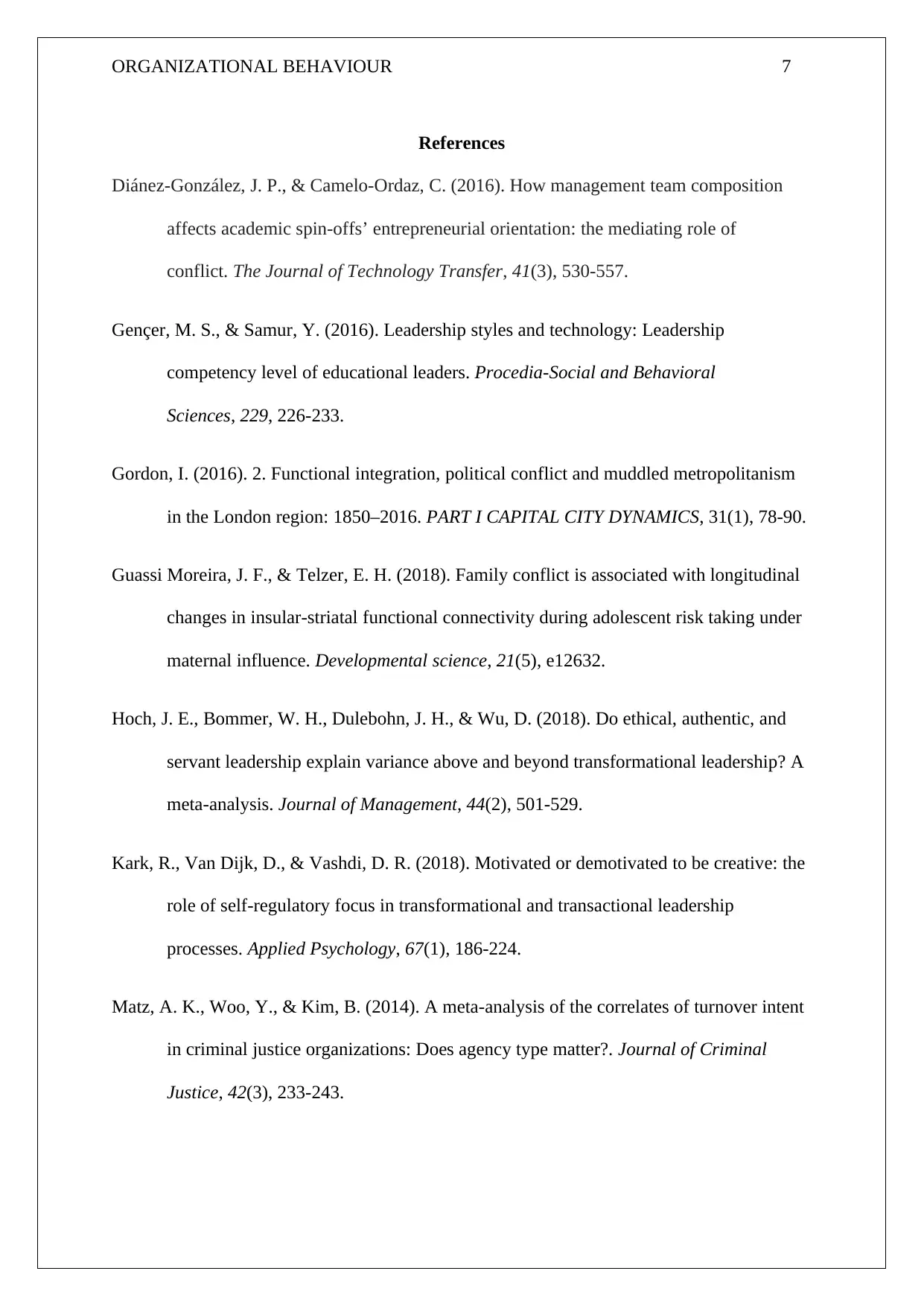
ORGANIZATIONAL BEHAVIOUR 7
References
Diánez-González, J. P., & Camelo-Ordaz, C. (2016). How management team composition
affects academic spin-offs’ entrepreneurial orientation: the mediating role of
conflict. The Journal of Technology Transfer, 41(3), 530-557.
Gençer, M. S., & Samur, Y. (2016). Leadership styles and technology: Leadership
competency level of educational leaders. Procedia-Social and Behavioral
Sciences, 229, 226-233.
Gordon, I. (2016). 2. Functional integration, political conflict and muddled metropolitanism
in the London region: 1850–2016. PART I CAPITAL CITY DYNAMICS, 31(1), 78-90.
Guassi Moreira, J. F., & Telzer, E. H. (2018). Family conflict is associated with longitudinal
changes in insular‐striatal functional connectivity during adolescent risk taking under
maternal influence. Developmental science, 21(5), e12632.
Hoch, J. E., Bommer, W. H., Dulebohn, J. H., & Wu, D. (2018). Do ethical, authentic, and
servant leadership explain variance above and beyond transformational leadership? A
meta-analysis. Journal of Management, 44(2), 501-529.
Kark, R., Van Dijk, D., & Vashdi, D. R. (2018). Motivated or demotivated to be creative: the
role of self‐regulatory focus in transformational and transactional leadership
processes. Applied Psychology, 67(1), 186-224.
Matz, A. K., Woo, Y., & Kim, B. (2014). A meta-analysis of the correlates of turnover intent
in criminal justice organizations: Does agency type matter?. Journal of Criminal
Justice, 42(3), 233-243.
References
Diánez-González, J. P., & Camelo-Ordaz, C. (2016). How management team composition
affects academic spin-offs’ entrepreneurial orientation: the mediating role of
conflict. The Journal of Technology Transfer, 41(3), 530-557.
Gençer, M. S., & Samur, Y. (2016). Leadership styles and technology: Leadership
competency level of educational leaders. Procedia-Social and Behavioral
Sciences, 229, 226-233.
Gordon, I. (2016). 2. Functional integration, political conflict and muddled metropolitanism
in the London region: 1850–2016. PART I CAPITAL CITY DYNAMICS, 31(1), 78-90.
Guassi Moreira, J. F., & Telzer, E. H. (2018). Family conflict is associated with longitudinal
changes in insular‐striatal functional connectivity during adolescent risk taking under
maternal influence. Developmental science, 21(5), e12632.
Hoch, J. E., Bommer, W. H., Dulebohn, J. H., & Wu, D. (2018). Do ethical, authentic, and
servant leadership explain variance above and beyond transformational leadership? A
meta-analysis. Journal of Management, 44(2), 501-529.
Kark, R., Van Dijk, D., & Vashdi, D. R. (2018). Motivated or demotivated to be creative: the
role of self‐regulatory focus in transformational and transactional leadership
processes. Applied Psychology, 67(1), 186-224.
Matz, A. K., Woo, Y., & Kim, B. (2014). A meta-analysis of the correlates of turnover intent
in criminal justice organizations: Does agency type matter?. Journal of Criminal
Justice, 42(3), 233-243.
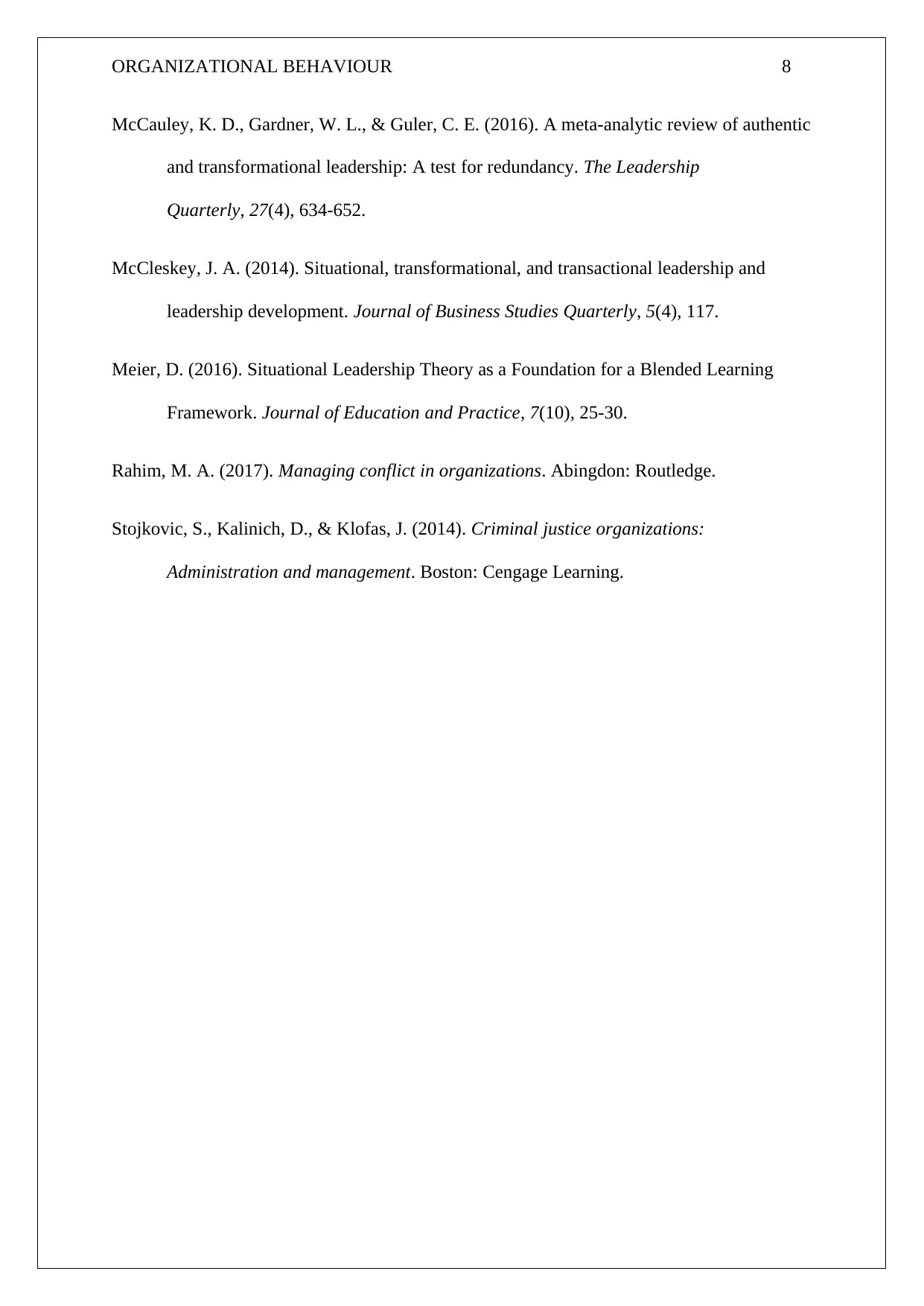
ORGANIZATIONAL BEHAVIOUR 8
McCauley, K. D., Gardner, W. L., & Guler, C. E. (2016). A meta-analytic review of authentic
and transformational leadership: A test for redundancy. The Leadership
Quarterly, 27(4), 634-652.
McCleskey, J. A. (2014). Situational, transformational, and transactional leadership and
leadership development. Journal of Business Studies Quarterly, 5(4), 117.
Meier, D. (2016). Situational Leadership Theory as a Foundation for a Blended Learning
Framework. Journal of Education and Practice, 7(10), 25-30.
Rahim, M. A. (2017). Managing conflict in organizations. Abingdon: Routledge.
Stojkovic, S., Kalinich, D., & Klofas, J. (2014). Criminal justice organizations:
Administration and management. Boston: Cengage Learning.
McCauley, K. D., Gardner, W. L., & Guler, C. E. (2016). A meta-analytic review of authentic
and transformational leadership: A test for redundancy. The Leadership
Quarterly, 27(4), 634-652.
McCleskey, J. A. (2014). Situational, transformational, and transactional leadership and
leadership development. Journal of Business Studies Quarterly, 5(4), 117.
Meier, D. (2016). Situational Leadership Theory as a Foundation for a Blended Learning
Framework. Journal of Education and Practice, 7(10), 25-30.
Rahim, M. A. (2017). Managing conflict in organizations. Abingdon: Routledge.
Stojkovic, S., Kalinich, D., & Klofas, J. (2014). Criminal justice organizations:
Administration and management. Boston: Cengage Learning.
⊘ This is a preview!⊘
Do you want full access?
Subscribe today to unlock all pages.

Trusted by 1+ million students worldwide
1 out of 9
Your All-in-One AI-Powered Toolkit for Academic Success.
+13062052269
info@desklib.com
Available 24*7 on WhatsApp / Email
![[object Object]](/_next/static/media/star-bottom.7253800d.svg)
Unlock your academic potential
Copyright © 2020–2025 A2Z Services. All Rights Reserved. Developed and managed by ZUCOL.